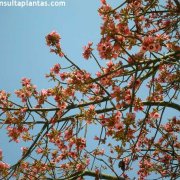Care of the tree Brachychiton discolor or Lacebark tree |
|
The genus Brachychiton, family Malvaceae, comprises 30 species of shrubs and trees native to Australia. Some species are: Brachychiton discolor, Brachychiton acerifolius, Brachychiton bidwillii, Brachychiton populneus, Brachychiton rupestre. Common names: Pink kurrajong, Scrub bottletree, Hat tree, Sycamore, Lacebark tree. This species is native to eastern Australia. They are pyramidal trees that reach 30 meters (98.4 feet) in height. They have lobed leaves, hairy in texture and dark green on the upper side (white on the underside). The flowers are bell-shaped and do not have petals but a pink calyx. They bloom in summer. They produce dark, boat-shaped fruits that can be used for floral decorations and bouquets. Sycamore is a fast-growing plant that is used as isolated specimens in gardens and in rows for public parks and streets. Brachychiton discolor grows in full sun or semi-shade exposures; it resists frosts down to -5 ºC (23 ºF). Pink kurrajong can be grown in any type of soil that is well drained. Planting is recommended in spring. Scrub bottletree resists drought well; water moderately waiting for the soil to dry out. Fertilize in early spring with manure or compost. Lacebark tree does not need pruning; only to remove damaged branches after flowering. Brachychiton discolor is a tree resistant to pests and diseases. Hat tree propagates by seeds sown in spring; they germinate in a few weeks. |
Images of the tree Brachychiton discolor or Lacebark tree |
Find plants
Brachychiton discolor or Lacebark tree | Care and Growing
© 2025 FavThemes


